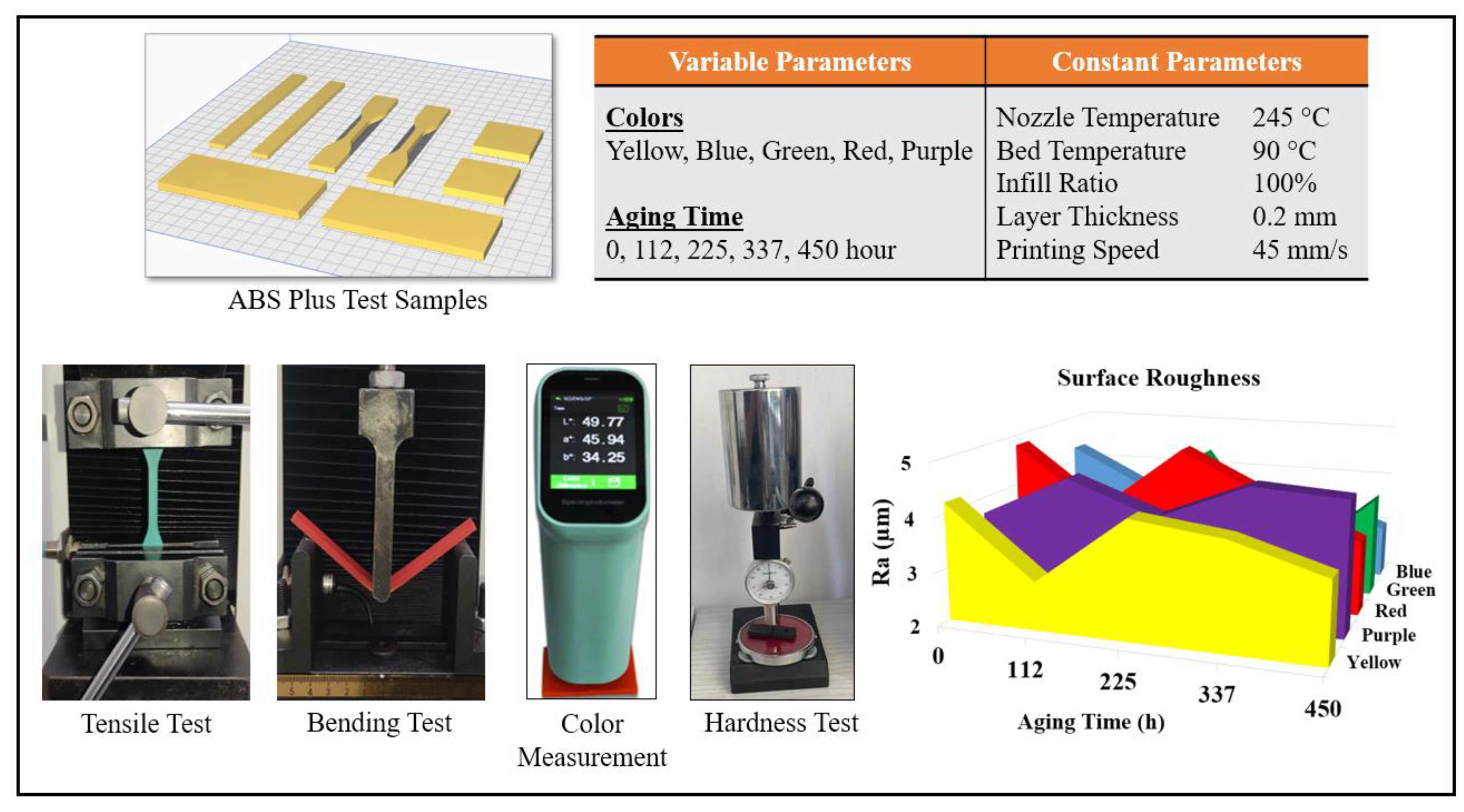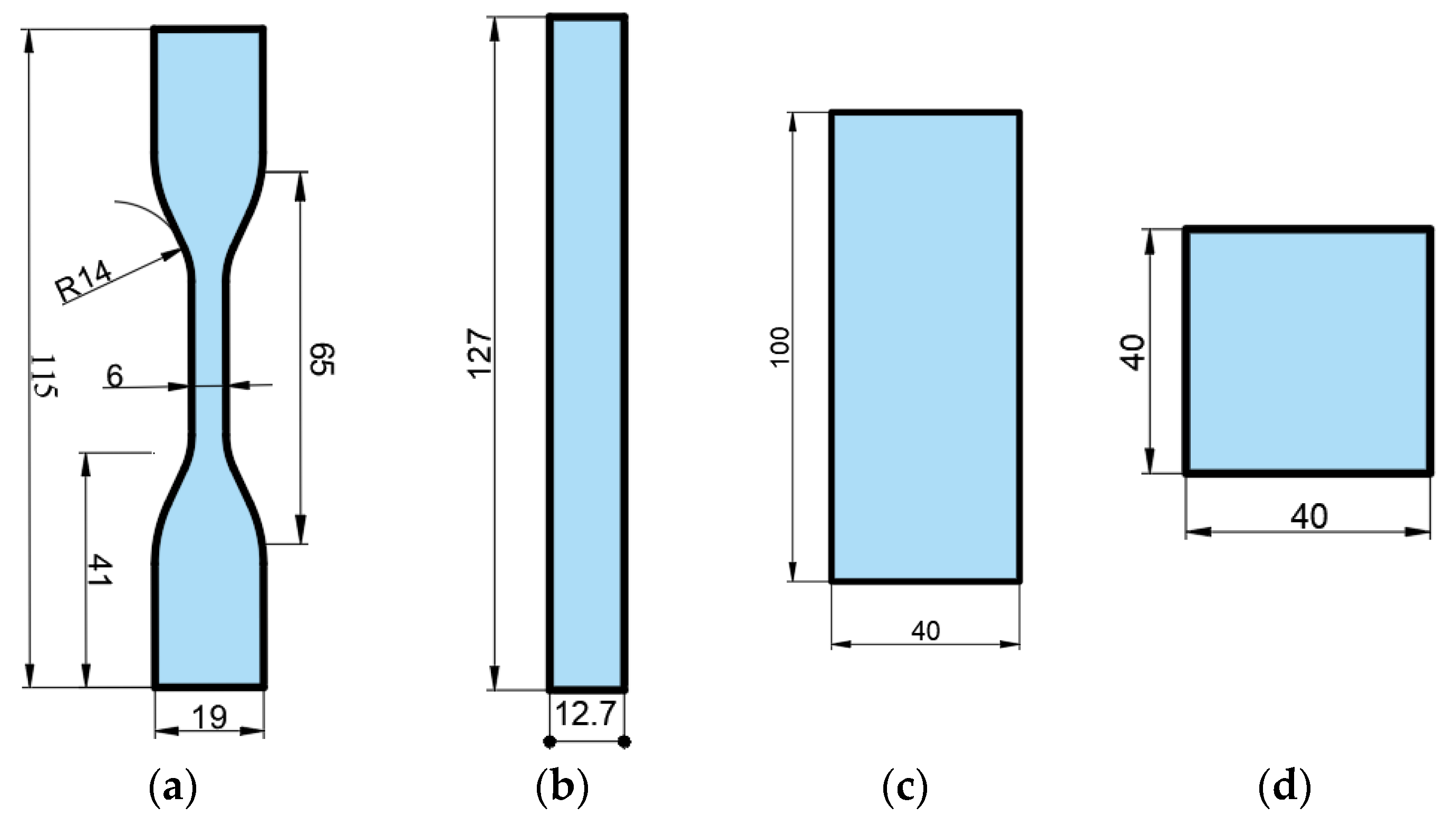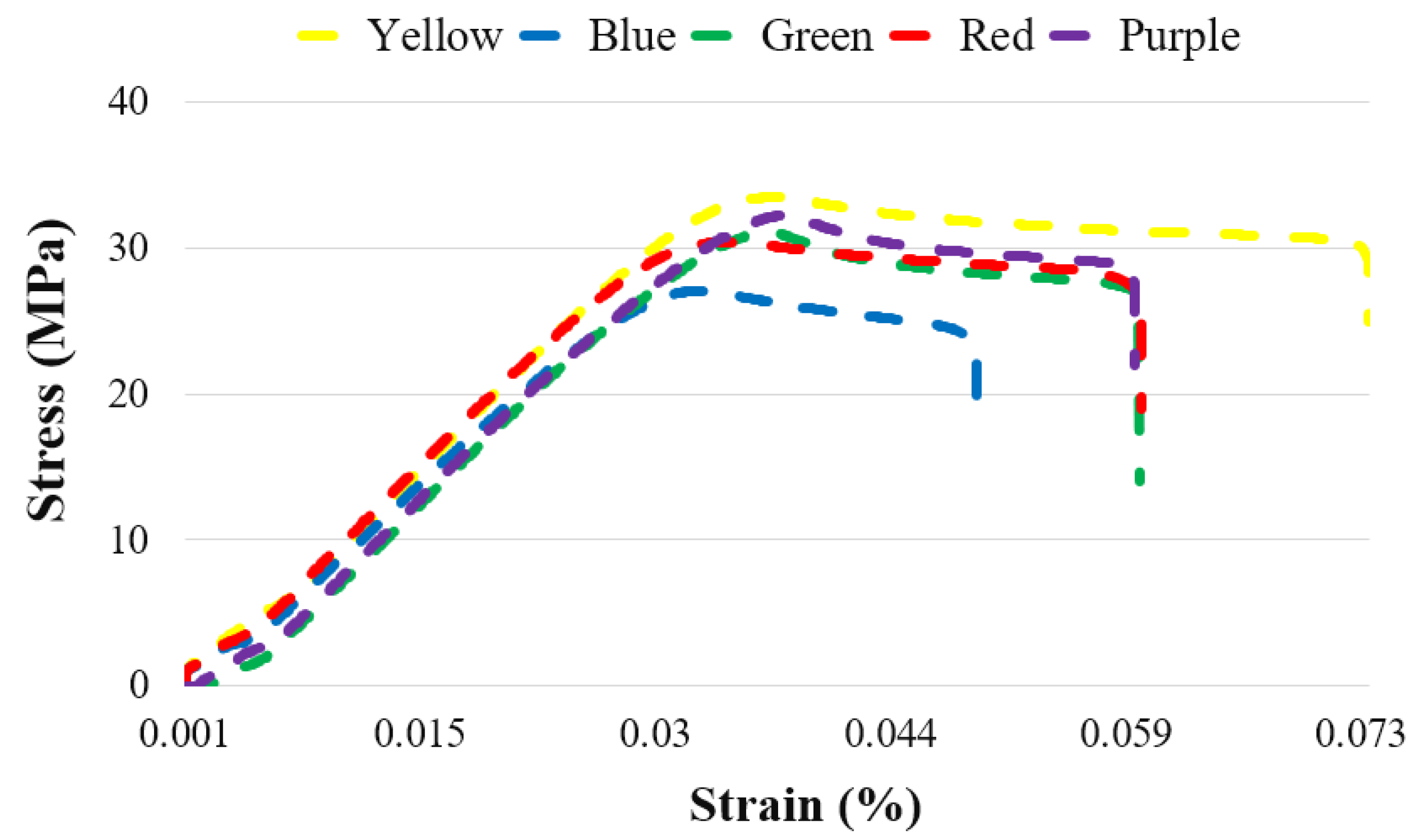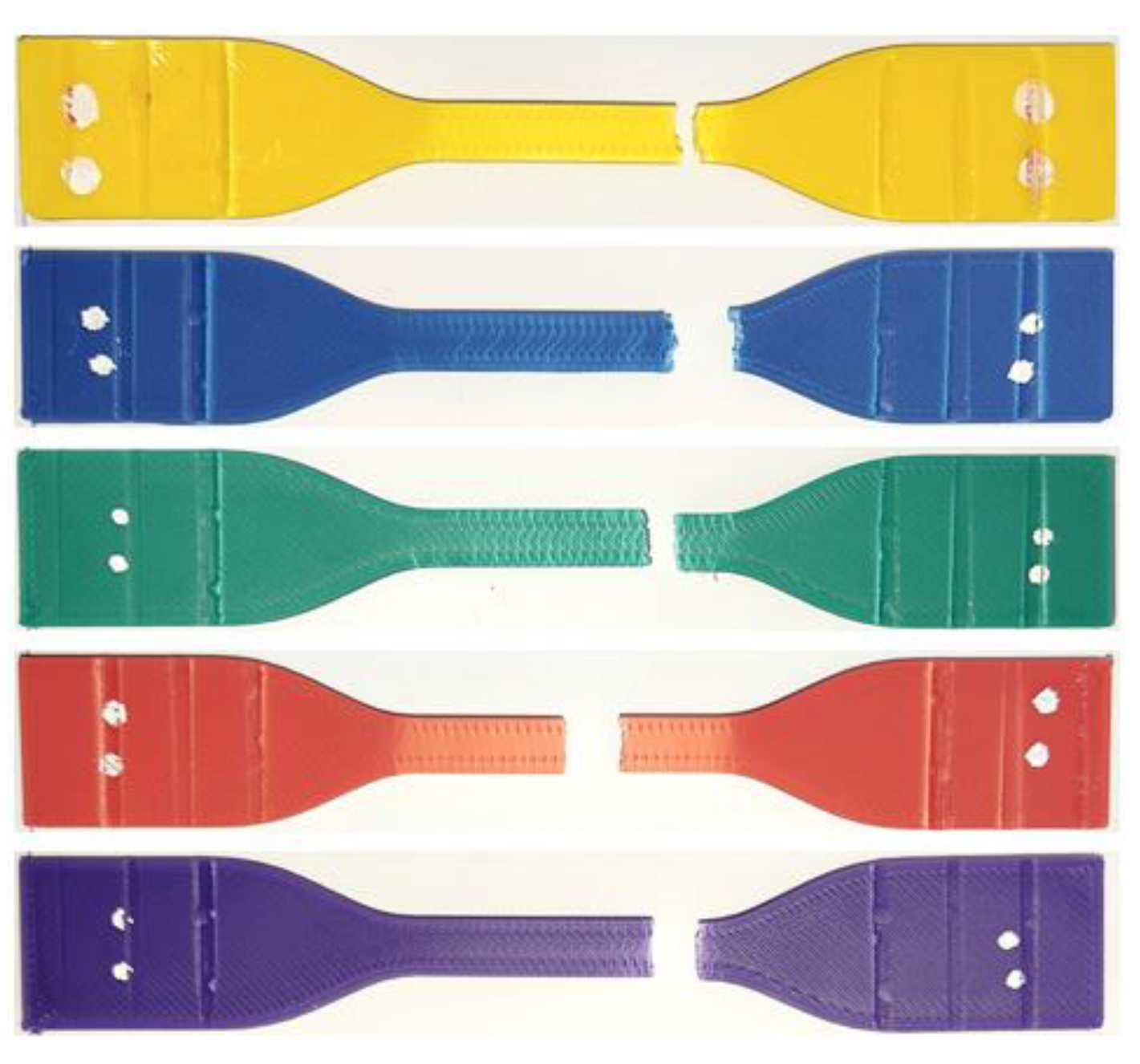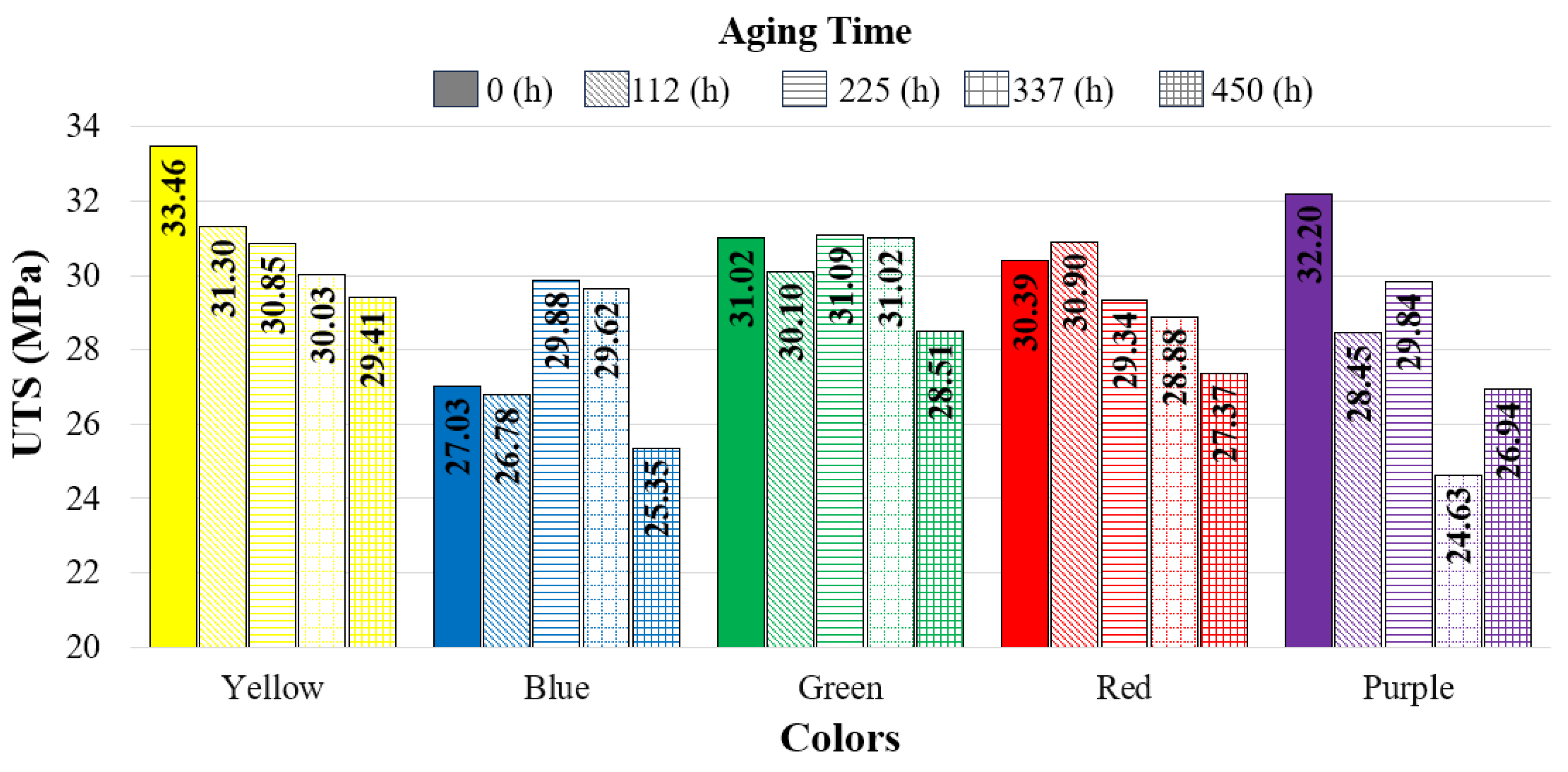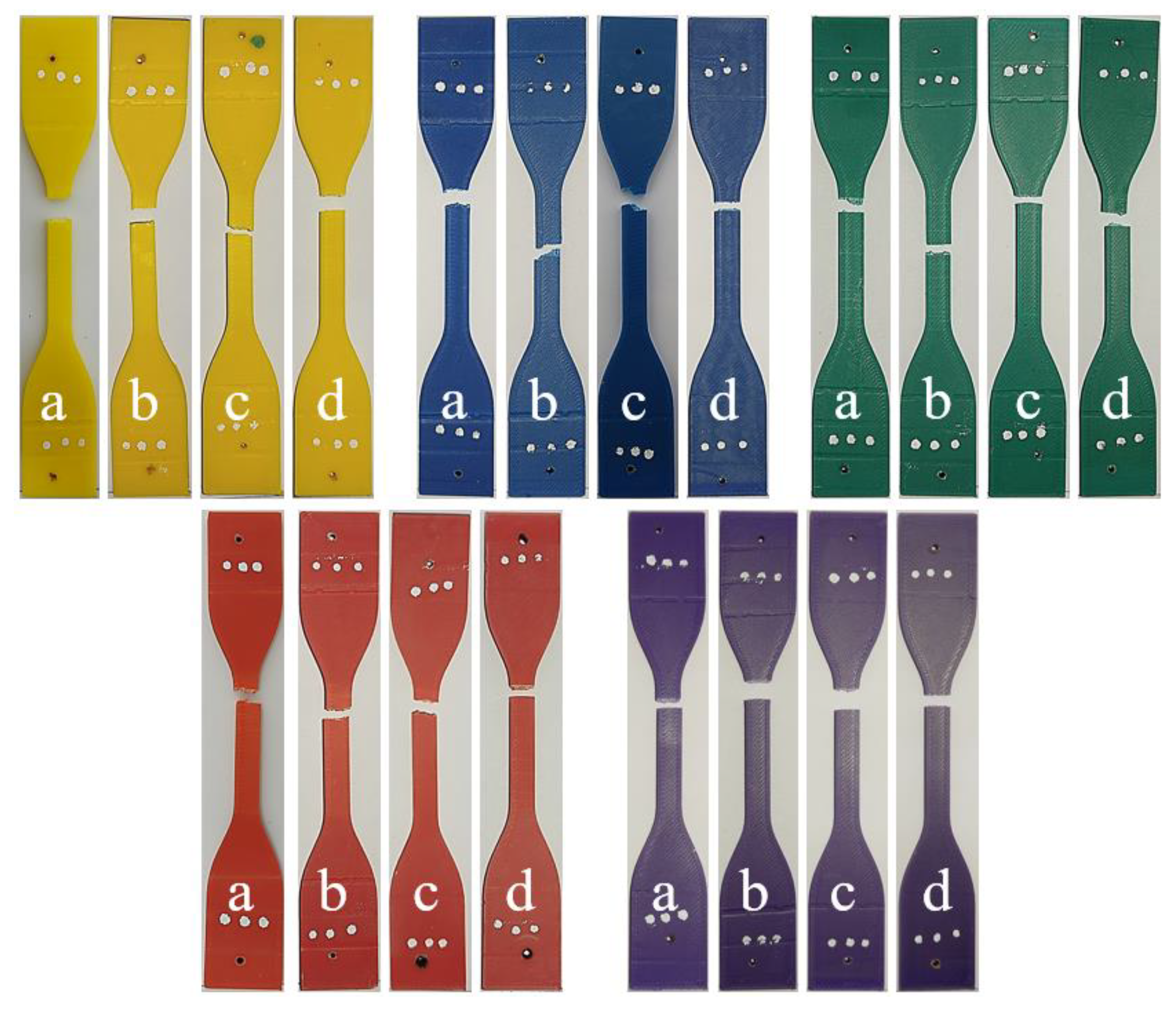3.1. Properties of the Base (Reference) Materials
In
Figure 3, the stress–strain curves of the unaged specimens for five different colors are presented, while
Table 2 shows their ultimate tensile strength (UTS) and percentage elongation values. Among the five colors tested, the highest tensile strength was observed in the yellow specimens at 33.46 MPa. This was followed by the purple (32.20 MPa), green (31.02 MPa), red (30.39 MPa), and blue (27.03 MPa) specimens, respectively. Examination of the elongation values revealed that the highest elongation was obtained in the yellow specimens, with 7.27%.
Gao et al. investigated the effect of color on the mechanical properties of ABS and PLA materials (eSUN, Beijing, China) by using seven different colors (red, yellow, blue, green, black, orange, purple, and natural). For all specimens, a layer thickness of 0.15 mm and an infill ratio of 100% were applied as process parameters. In ABS, the highest UTS value was recorded for the red specimens at 24.9 MPa, followed by the green and yellow specimens at 24 MPa and 22 MPa, respectively. In PLA specimens, the highest UTS was observed in the purple specimens at 52.5 MPa, while the yellow and orange specimens showed values of 51.7 MPa and 50.6 MPa, respectively [
28]. Frunzaverde et al. examined the effect of color (gray, red, natural, and black) and layer thickness (0.05, 0.10, 0.15, and 0.20 mm) on the mechanical properties of PLA. At all layer thicknesses, the highest tensile strength (UTS) was obtained in the gray specimens [
29]. Wittbrodt et al. investigated the effects of color by using natural, black, gray, blue, and white PLA. As a result, they reported that the natural color material exhibited the highest UTS value [
30].
In the literature, studies examining the relationship between color and mechanical properties have rarely focused on ABS materials, while more research has been conducted on PLA. A common finding across these studies is that the mechanical properties vary depending on the filament color. However, the color reported to have the best mechanical properties differs across studies. This variation can be attributed to the use of different filament brands in these studies. Another reason is that filament manufacturers employ different colorants to produce the desired filament colors.
In
Figure 4, the bending test graphs of the unaged specimens are presented, and
Table 3 shows the maximum bending force and displacements recorded during the bending tests. Among the five different colors tested, the highest bending force was observed in the green specimens at 58.46 N. This was followed by the purple (56.18 N), yellow (54.88 N), blue (54.59 N), and red (54.40 N) specimens, respectively. In their study, Gao et al. reported the highest flexural strength in the green specimens at 35.6 MPa, followed by the purple specimens at 35.1 MPa [
28]. The findings of Gao et al. are consistent with the results of the present study.
Figure 5 shows the fracture surfaces of the reference specimens after tensile test. When the reference specimens are compared with one another, it can be observed that although their colors differ, the fracture shapes are similar. In the fracture region, dense lines perpendicular to the applied tensile stress are visible. In bending test sample, it is clearly seen that in the yellow and red bending specimens, the lines caused by the applied load appear as cracks in the fracture region. In contrast, in the green, purple, and blue bending specimens, although the bending occurred in the same measurement region as the other specimens, bending deformation due to stress was observed on the fracture surfaces.
3.2. Tensile Strength After Aging
Figure 6 presents the variation in UTS with aging durations, while
Table 4 shows the stress–strain values corresponding to different aging durations. In the yellow specimens, UTS decreased as the aging duration increased. The lowest UTS for the yellow specimens (29.41 MPa) was recorded after 450 h of aging.
In the blue specimens, the lowest UTS was recorded at 25.35 MPa after 450 h of aging. Compared to the reference specimen (27.03 MPa), the UTS of the blue specimens increased at 225 h (29.88 MPa) and 337 h (29.62 MPa). For the green specimens, the UTS values of the reference, 112, 225, and 337 h aged specimens were found to be similar, while an 8% decrease was observed after 450 h of aging compared to the reference. In the red specimens, a 1.6% increase in UTS was observed at 112 h compared to the reference, whereas decreases occurred at the other aging durations. The greatest reduction for the red specimens was recorded after 450 h of aging (27.37 MPa), corresponding to a 9.9% decrease.
In the purple specimens, the greatest decrease in UTS was observed after 337 h of aging, with a reduction of 23.5%. Among the five colors tested, the purple specimens exhibited the most inconsistent behavior with respect to aging duration. Amza et al. conducted aging tests on ABS/PC specimens produced by 3D printing using UV-B (λ = 315 nm) and UV-C (λ = 254 nm) irradiation for 24 h. After aging, no significant change in tensile strength was observed (reference: 39.26 MPa, UV-B: 39.51 MPa, UV-C: 38.53 MPa), while compressive strength decreased by 5.2% under UV-B and 6.5% under UV-C exposure [
14]. Ünal et al. subjected ABS Plus specimens in three different colors (yellow, green, and blue) and with three different infill ratios (50%, 75%, and 100%) to a 96 h salt spray test at 35 °C. As a result, they reported a slight increase in the yellow and green specimens at 100% infill ratio, while a slight decrease was observed in the blue specimens [
31]. These two studies demonstrate that after 24 h (UV-B and UV-C) and 96 h (salt spray) of aging, the mechanical properties were only minimally affected. In the present study, however, it was determined that both color and aging duration had a significant effect on the variation in tensile strength.
Popescua et al. examined the aging behavior of ABS materials used in the healthcare sector under natural aging (storage environment) and repeated sterilization conditions. In their study, the samples were divided into two groups: Group 1 (control group) was subjected only to natural aging, while the samples in Group 2 were exposed to both aging and multiple sterilization processes. As a result, they reported that aging caused by natural storage and sterilization did not lead to a significant change in the mechanical properties of the materials [
32].
Boldizara and Möller investigated the changes in the mechanical properties of ABS material subjected to repeated extrusion, aging, and combined extrusion/aging cycles. The aging process was carried out by keeping the samples at 90 °C for 72 h after extrusion. As a result, it was observed that with an increasing number of cycles, the elongation at break significantly decreased in the aged samples, while it increased in the extruded samples. In the samples subjected to both extrusion and aging, the elongation at break exhibited a fluctuating behavior [
33].
Bergaliyeva et al. investigated the effects of thermal and hydrothermal aging on PLA materials. For thermal aging, the samples were kept at 50 °C, while for hydrothermal aging, they were exposed to 50 ± 2 °C and 70 ± 5% humidity for 8, 16, 24, 48, 72, 168, 672, and 1344 h. As a result, thermal aging led to an increase in mechanical properties in all samples compared to the reference, whereas hydrothermal aging caused a decrease in mechanical properties after 1344 h of exposure [
34].
Amza et al. evaluated the effects of UVC aging on PLA and PETG. For this purpose, the printed samples were exposed to UVC for 24 h and then allowed to cool at room temperature for 4 h. By comparing the control group with the aged samples, they examined the tensile strength, compressive strength, and creep behavior. As a result, it was reported that PLA parts showed no visible changes in appearance after aging, whereas PETG samples exhibited darkening and yellowing. In terms of mechanical properties, tensile strength decreased by 9.1% in PLA and 38.1% in PETG, while compressive strength decreased by 13.1% in PLA and 33.9% in PETG [
35].
A review of the literature shows that various studies have been conducted using different aging techniques and materials. These studies have investigated the effects of natural, thermal, UV, and hydrothermal aging methods on the most commonly used 3D printing materials. A common point among previous studies is that the aging duration and aging temperature [
36] significantly affect material degradation, and it is necessary to evaluate the behavior of parts under outdoor environmental conditions.
Figure 7 shows the fracture images of the tensile specimens after different aging durations. When these specimens are compared among themselves, it is observed that the fractures occurred in the measurement region and displayed similar shapes. However, when evaluated together with the reference specimens (
Figure 5), it can be seen that the aged specimens exhibited smoother fracture surfaces. This can be explained by the adverse effects of aging on the polymer structure, leading to embrittlement of the material.
Figure 8 presents the scanning electron microscope (SEM) images of the fracture surfaces of the tensile test specimens after aging (a: green, b: red, c: purple, d: yellow, e: green). In the images, the upper part of each specimen represents the aged region, while the lower part corresponds to the unaged region. Examination of the SEM images revealed distinct differences between the surfaces exposed to xenon light and those that were not.
In all colors, the surfaces exposed to xenon light (particularly in the regions close to the outer surface) were observed to become embrittled and exhibit a more fragile structure. This can be attributed to changes in the chemical bond structures of the aged surfaces under the influence of radiation and temperature, resulting in a harder and more brittle morphology. In contrast, the surfaces not exposed to xenon light displayed ductile fracture behavior. In addition to radiation exposure, the repeated heating of the surfaces and their sudden cooling through spraying led to the formation of a hard and brittle structure extending from the outer surface toward the interior. In particular, as seen in
Figure 8c, the purple specimens, due to the wavelength associated with their color, were more strongly affected and exhibited harder and more brittle behavior.
The observed increase in hardness, measured on the sample surface, is directly related to chain scission and cross-linking chemical processes, as well as the resulting changes in the polybutadiene (PB) phase. This local increase in hardness and stress hardening has been shown to cause brittleness and brittle behavior in the polymer. Therefore, it can be concluded that the increase in hardness serves as physical evidence of chain scission in the polybutadiene (PB) phase and surface degradation through cross-linking. The combination of these phenomena ultimately leads to the polymer becoming brittle [
37,
38,
39,
40].
3.3. Bending Results After Aging
Figure 9 presents the variation in bending forces with aging durations and filament colors, while
Table 5 provides the corresponding force–displacement values. For all colors, the bending force increased after 112 h of aging. The bending force values for the purple, green, red, blue, and yellow specimens were determined as 59.20 N, 58.46 N, 56.49 N, 56.43 N, and 56.05 N, respectively, from highest to lowest. In the yellow and red specimens, the bending force decreased with longer aging durations (225, 337, and 450 h). In the blue and green specimens, a sharp decrease in bending force was observed after 112 h of aging, followed by an increase as aging duration progressed. For the purple specimens, the bending force sharply decreased at 225 h, increased again at 337 h, and then dropped once more.
The fracture surfaces of the bending specimens according to aging durations. It was observed that all aged test specimens bent at the loading point after the bending test but did not fracture completely. As the aging duration increased, the fracture appearance became more pronounced, and the cracks were observed to follow a straight-line path across the width of the specimens.
3.5. Color and Gloss After Aging
In this study, the 3D-printed parts were first examined by visual inspection. Although the parts were produced from the same material, differences in surface gloss and matte appearance were observed. After aging, the total color change was found to increase with aging duration.
The greatest total color change values were measured in the specimens exposed to 450 h of aging. When all colors were evaluated together, the highest total color change was found in the purple specimens. When each color was assessed individually in comparison to its reference specimen, the largest color change was observed in the yellow specimens, while the smallest color change was observed in the green specimens.
Table 6 presents the total color change of the specimens. These results also indicate an increase in the L* gloss value. An increase in the L* value suggests that the specimens began to fade and exhibit more gloss. This situation may be attributed not only to the degradation of ABS but also to the type of colorant additives used [
22].
Figure 11 shows the relationship between total color change and UTS (ultimate tensile strength). According to this graph, in the reference samples (0 h), the tensile strength, from highest to lowest, was found in the yellow (33.46 MPa), purple (32.20 MPa), green (30.10 MPa), red (30.39 MPa), and blue (27.03 MPa) samples.
The strength of the yellow and purple samples decreased depending on the aging duration. While the strength values measured after aging in the yellow samples were relatively close to each other, the decrease in the purple samples was much more pronounced. It was observed that the green samples reached higher strength than the blue samples and that their color changes were also less than those of the blue samples.
For the red samples, no significant difference in strength was observed at aging durations of 112 and 225 h, whereas a decrease in strength was noted at 337 and 450 h. In the green and blue samples, the effect of aging on strength became most evident at 450 h. Moreover, the strength increase–decrease trends of the blue and green samples depending on aging duration exhibited similar reactions.
Figure 12 presents the relationship between total color change and bending force. As can be seen from this graph, for the reference samples (0 h), the bending force, from highest to lowest, was measured in the green (58.46 MPa), purple (56.18 MPa), yellow (54.88 MPa), blue (54.59 MPa), and red (54.40 MPa) samples. When the reference materials were compared, the bending force of the samples increased at 112 h of aging; however, as the aging duration increased (225, 337, and 450 h), the bending force values of the samples decreased. The largest difference in bending force between the reference and aged samples was observed in the purple samples.
Figure 13 shows the surface appearances of the test samples before and after aging. It can be observed that there is a noticeable color change in the samples after aging. Since the gloss measurement values were below 10 GU, a measurement angle of 85° was adopted. These values are presented as the gloss of the samples. Based on the evaluation before and after aging, the purple samples were found to have the highest surface gloss.
The purple samples, which were determined to have the highest gloss, are also the parts most affected by the aging process. This result, consistent with the literature, indicates that the ABS material and pigment structure have begun to deteriorate [
22].
Table 7 presents the gloss measurement values of the samples before and after aging. For the reference samples, gloss was found to range between 2.5 and 5.6 GU, whereas for the aged samples, it ranged between 2.5 and 7.7 GU. Gloss refers to the ability of a surface to reflect light from a specific angle, and the main factors affecting gloss are the surface roughness of the object and its molecular structure [
41]. Pigments undergo changes under the influence of light. This change is related to the chemical structure, concentration, and physical state (particle size and structure) of the pigment. Therefore, the reflection properties of the surface vary depending on the different pigments present in the colored filaments [
22]. In this study, it was observed that gloss values changed depending on the aging duration. Compared to the reference samples, the greatest changes in gloss were measured at aging durations of 337 and 450 h.
Fiorio et al. investigated the properties of ABS after aging by adding different masterbatches. The prepared samples were molded using plastic injection and then subjected to aging and subsequent recycling. Their experimental design included cyclic aging processes, and the mechanical and optical properties were measured after each operation. As a result, it was observed that the mechanical properties of the masterbatch-containing samples decreased after the first aging cycle. In subsequent aging cycles, the mechanical properties of the samples were reported to approach the values observed in the reference samples. Regarding the yellowing index of the parts, an increase was observed both after aging and following mechanical recycling. The authors attributed this change to polymer degradation [
42].
In another study, it was found that as the aging duration of ABS plastics increased, both color change and absorbance increased. This was explained by the fact that aging-induced degradation primarily affects the surface of the material, with minimal chemical changes occurring within the material during aging. It was reported that as degradation progressed and absorbance increased, significant yellowing occurred. The observed degradation during aging was attributed to oxidation of the butadiene double bonds, formation of aldehydes or ketones, some chain scissions, and changes in the molecular weight of the ABS polymer [
43]. These studies confirm that aging in polymers is accompanied by degradation and associated color changes.
Table 8 presents the surface roughness measurement results of the samples before and after aging. The surface roughness of the reference samples before aging ranged from 2.66 to 4.18 µm, whereas after aging, it was measured between 2.37 and 4.97 µm. The surface roughness of the purple samples increased markedly due to the effect of aging, while it decreased in the blue and yellow samples. In addition, the surface roughness of the green samples increased with aging, whereas in the red samples it tended to decrease.
In a study on the aging of ABS plates produced by injection molding [
44], it was found that aging had a significant effect on the gloss and color of the parts. It was stated that the reduction in gloss as a result of artificial aging could be associated with a slight increase in the surface roughness of the samples. This study indicated that degradation might cause a change in the refractive index of the surface layers of the parts, which could in turn lead to a slight decrease in gloss level. In polymer parts produced by additive manufacturing, however, surface quality challenges differ considerably from those in conventional manufacturing. Poor surface quality and geometric deviations are often encountered. Nevertheless, there is no uniform standard for evaluating the roughness and dimensional accuracy of 3D-printed parts [
45]. Sears found that the tensile strengths of polylactic acid (PLA) filaments of different colors (red, blue, yellow, and orange) varied. He also suggested that printing PLA filaments of different colors, even under the same printing settings, could affect print quality. One of the defining features of high-quality 3D printing is good surface quality. However, it is not always easy to identify the conditions affecting the surface quality of 3D-printed parts, since even parts produced with the same printing parameters and conditions may exhibit variations in surface roughness [
46].
